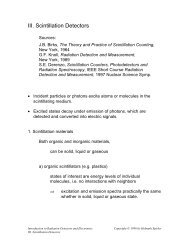Introduction to radiation-resistant semiconductor devices and circuits
Introduction to radiation-resistant semiconductor devices and circuits
Introduction to radiation-resistant semiconductor devices and circuits
You also want an ePaper? Increase the reach of your titles
YUMPU automatically turns print PDFs into web optimized ePapers that Google loves.
equired performance characteristics over the lifetime of the system. The former<br />
approach tends <strong>to</strong> utilize mediocre <strong>to</strong> poor technologies that remain so over the<br />
course of operation. The latter starts out with superior characteristics, which<br />
gradually deteriorate under ir<strong>radiation</strong>. Depending on the specific system, these<br />
designs may die gradually, although at some fluence or dose a specific circuit, typically<br />
digital, may cease <strong>to</strong> function at all. Clearly, the best mitigation technique is<br />
<strong>to</strong> avoid the problem, either by shielding or by reducing the electronics in the<br />
<strong>radiation</strong> environment <strong>to</strong> the minimum required <strong>to</strong> do the job. The latter runs<br />
counter <strong>to</strong> prevailing trends, which favor digitizing as close <strong>to</strong> the front-end as<br />
possible <strong>and</strong> tend <strong>to</strong> implement even simple control functions with digital circuitry.<br />
Detec<strong>to</strong>rs<br />
Increased detec<strong>to</strong>r leakage current has several undesirable consequences.<br />
1. The integrated current over typical signal processing times can greatly<br />
exceed the signal.<br />
2. Shot noise increases.<br />
3. The power dissipated in the detec<strong>to</strong>rs increases (Idet⋅Vdet)<br />
Since the leakage current decreases exponentially with temperature, cooling is<br />
the simplest technique <strong>to</strong> reduce diode leakage current. For example, reducing the<br />
detec<strong>to</strong>r temperature from room temperature <strong>to</strong> 0 °C reduces the bias current <strong>to</strong><br />
about 1/6 of its original value.<br />
Detec<strong>to</strong>r power dissipation is a concern in large-area silicon detec<strong>to</strong>rs for the<br />
LHC, where the power dissipation in the detec<strong>to</strong>r diode itself can be of order 1 <strong>to</strong><br />
10 mW/cm 2 . Since the leakage current is an exponential function of temperature,<br />
local heating will increase the leakage current, which will increase the local<br />
heating, <strong>and</strong> so on, ultimately taking the device in<strong>to</strong> thermal runaway. To avoid<br />
this potentially catastrophic failure mode, the cooling system must be designed <strong>to</strong><br />
provide sufficient cooling of the detec<strong>to</strong>r, a challenging (but apparently doable)<br />
task in a system that is <strong>to</strong> have zero mass.<br />
Reducing the integration time reduces both baseline changes due <strong>to</strong> integrated<br />
detec<strong>to</strong>r current <strong>and</strong> shot noise. Clearly, this is limited by the duration of the signal<br />
<strong>to</strong> be measured. To some degree, circuitry can be designed <strong>to</strong> accommodate large<br />
baseline shifts due <strong>to</strong> detec<strong>to</strong>r current, but at the expense of power. AC coupled<br />
detec<strong>to</strong>rs eliminate this problem. In instrumentation systems that require DC<br />
coupling, correlated double sampling techniques can be used <strong>to</strong> sample the baseline<br />
before the signal occurs <strong>and</strong> then subtract from the signal measurement.<br />
21





